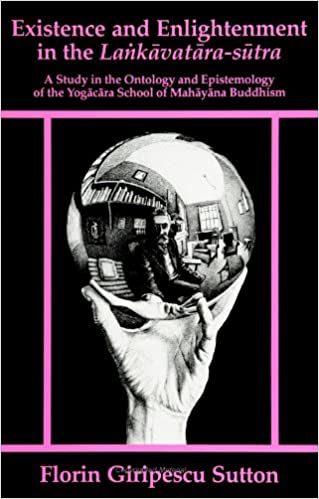Existence and Enlightenment in the Laṅkāvatāra-Sūtra
< Books
| Line 2: | Line 2: | ||
|FullTextRead=No | |FullTextRead=No | ||
|BookToc=*{{i|Foreword|xiii}} | |BookToc=*{{i|Foreword|xiii}} | ||
| + | |||
*{{i|Preface|xv}}<br><br> | *{{i|Preface|xv}}<br><br> | ||
| + | |||
<center>'''Introduction'''</center> | <center>'''Introduction'''</center> | ||
| + | |||
*{{i|0.1. The Purpose of the Study, and the Significance of the<br> ''Laṅkāvatāra-sūtra'' within Buddhist Doctrinal History|1}} | *{{i|0.1. The Purpose of the Study, and the Significance of the<br> ''Laṅkāvatāra-sūtra'' within Buddhist Doctrinal History|1}} | ||
| + | |||
*{{i|0.2. Dating the Text: Problems of Form and Interpretation|13}} | *{{i|0.2. Dating the Text: Problems of Form and Interpretation|13}} | ||
| + | |||
*{{i|0.3. Methodology and Outline of the Study|23}}<br><br> | *{{i|0.3. Methodology and Outline of the Study|23}}<br><br> | ||
| + | |||
<center>'''Part One: Concepts of Being'''</center> | <center>'''Part One: Concepts of Being'''</center> | ||
| + | |||
*{{i|1.0. The Nature of Buddhist Ontology|39}} | *{{i|1.0. The Nature of Buddhist Ontology|39}} | ||
* General considerations * The practical aim of the Yogācāra Philosophy | * General considerations * The practical aim of the Yogācāra Philosophy | ||
| + | |||
*{{i|1.1. The Threefold Meaning of Tathāgata-garbha and its<br> Relation to Ālaya-vijñāna: the ''Essence'' of Being|51}} | *{{i|1.1. The Threefold Meaning of Tathāgata-garbha and its<br> Relation to Ālaya-vijñāna: the ''Essence'' of Being|51}} | ||
* Preliminary considerations * Tathagāta-garbha as essential, supramundane,<br> pure dharma, and its contrast with the Hindu Ātman * Tathagata-garbha<br> as embryo, and the dynamics of Buddhahood * Tathāgata-garbha<br> as womb or matrix of Buddhahood * Conclusion | * Preliminary considerations * Tathagāta-garbha as essential, supramundane,<br> pure dharma, and its contrast with the Hindu Ātman * Tathagata-garbha<br> as embryo, and the dynamics of Buddhahood * Tathāgata-garbha<br> as womb or matrix of Buddhahood * Conclusion | ||
| + | |||
*{{i|1.2. The Five Skandhas: the ''Temporal'' Manifestation of Being|79}}<br> Introduction * Brief overview of the Ātman controversy prior to the<br> ''Laṅkāvatāra-sūtra'' * Rūpa, or the formative elements of the five Skandhas<br> * Nāma, or the formless elements of the five Skandhas * The Skandhas and<br> the empirical self, or personality * The Skandhas and the trans-empirical<br> Self, the Tathāgata * The five Skandhas and the denial of metaphysical<br> dualities * Concluding remarks on the notion of Self and its varieties<br> | *{{i|1.2. The Five Skandhas: the ''Temporal'' Manifestation of Being|79}}<br> Introduction * Brief overview of the Ātman controversy prior to the<br> ''Laṅkāvatāra-sūtra'' * Rūpa, or the formative elements of the five Skandhas<br> * Nāma, or the formless elements of the five Skandhas * The Skandhas and<br> the empirical self, or personality * The Skandhas and the trans-empirical<br> Self, the Tathāgata * The five Skandhas and the denial of metaphysical<br> dualities * Concluding remarks on the notion of Self and its varieties<br> | ||
| + | |||
*{{i|1.3. Dharmadhātu: the ''Spatial'' or Cosmic Dimension of Being|117}}<br> Introductory remarks * Dharmādhatu as cosmic Law: the fundamental<br> structure of the universe * Dharmādhatu as universal Void: the ground<br> of Being * Concluding observations<br><br> | *{{i|1.3. Dharmadhātu: the ''Spatial'' or Cosmic Dimension of Being|117}}<br> Introductory remarks * Dharmādhatu as cosmic Law: the fundamental<br> structure of the universe * Dharmādhatu as universal Void: the ground<br> of Being * Concluding observations<br><br> | ||
Revision as of 16:24, 15 June 2023
This book offers a systematic analysis of one of the most important concepts characterizing the Yogācāra School of Buddhism (the last creative stage of Indian Buddhism) as outlined and explained in one of its most authoritative and influential texts, Laṅkāvatāra-sūtra. Compiled in the second half of the fourth-century A.D., this sūtra not only represents a comprehensive synthesis of both early and late religio-philosophical ideas crucial to the understanding of Buddhism in India, but it also provides an insight into the very early roots of the Japanese Zen Buddhism in the heart of the South Asian esotericism.
The first part of the book outlines the three-fold nature of Being, as conceptualized in Buddhist metaphysics. The author uses an interpretive framework borrowed from the existentialist philosophy of Heidegger, in order to separate the transcendental Essence of Being from its Temporal manifestation as Self, and from its Spatial or Cosmic dimension. The second part clarifies the Buddhist approach to knowledge in its religious, transcendental sense and it shows that the Buddhists were actually first in making use of dialectical reasoning for the purpose of transcending the contradictory dualities imbedded in the common ways of perceiving, thinking, and arguing about reality. (Source: SUNY Press)
| Citation | Sutton, Florin Giripescu. Existence and Enlightenment in the Laṅkāvatāra-Sūtra: A Study in the Ontology and Epistemology of the Yogācāra School of Mahāyāna Buddhism. SUNY Series in Buddhist Studies. Albany: State University of New York Press, 1991. https://archive.org/details/lankavatarafgsuttonexistenceandenlightenmentinthelankavatarasutraastudyintheonto_202003_621_R/mode/2up. |
|---|---|


